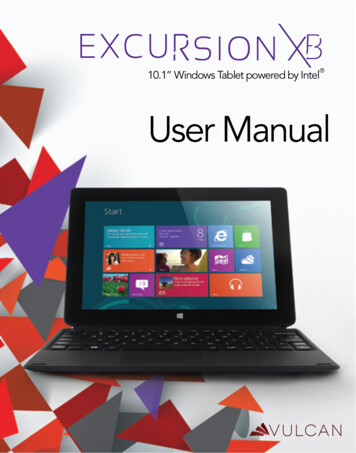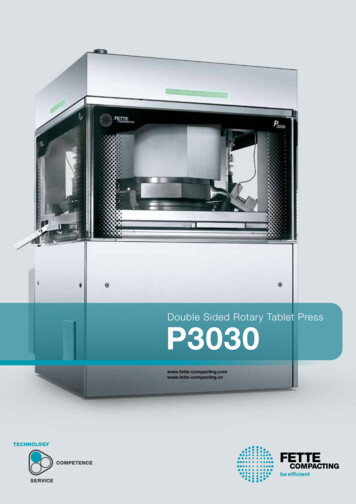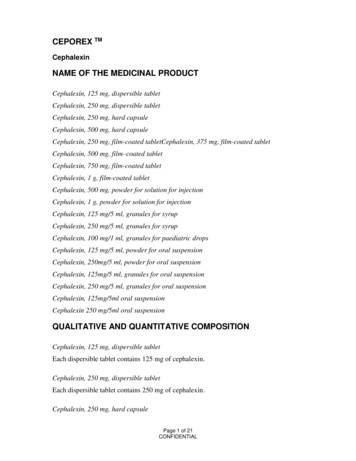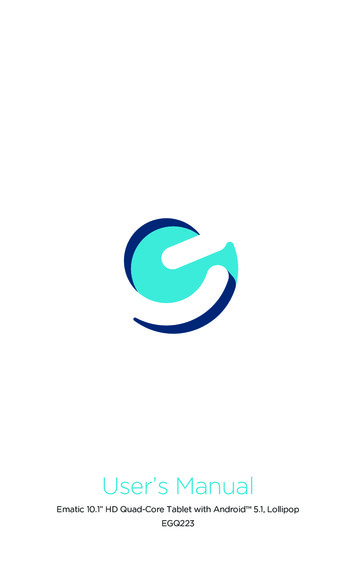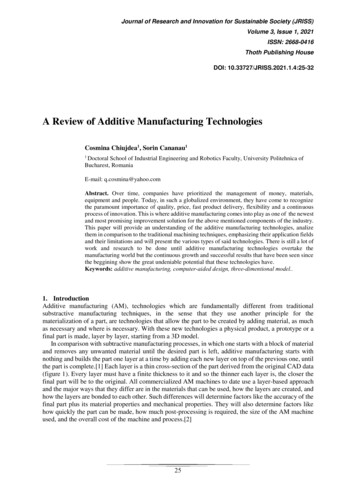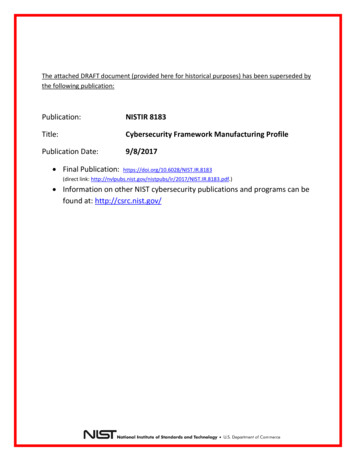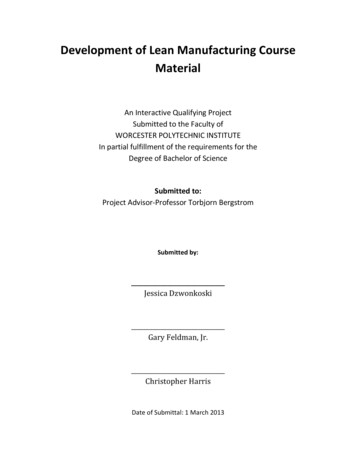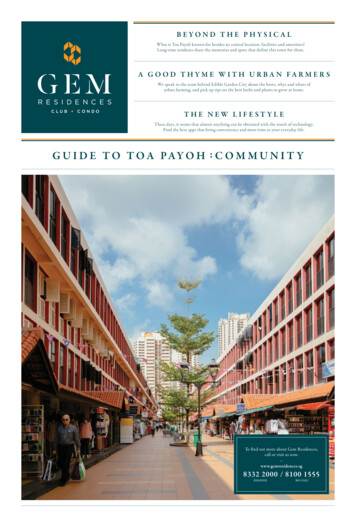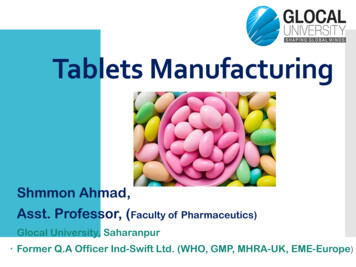
Transcription
Tablets Manufacturing Shmmon Ahmad, Asst. Professor, (Faculty of Pharmaceutics) Glocal University, Saharanpur Former Q.A Officer Ind-Swift Ltd. (WHO, GMP, MHRA-UK, EME-Europe)
INTRODUCTION Tablets may be defined as the solid unit dosage form ofmedicament or medicaments with suitable excipients andprepared either by molding or by compression. Itcomprises a mixture of active substances and excipients, Tablets formation process consist of a series of steps(unit processes)– weighing, milling, mixing,granulation, drying, compaction, (frequently) coatingand packaging. Regardless of the method used the unitprocesses – weighing, milling and mixing, are thesame; subsequent steps differ.2
3Primary goals of tablet manufacturing process To formulate tablets that are strong and hard to withstandmechanical shock encountered during manufacturing, packing,shipping, dispensing and use. To formulate tablets that are uniform in weight and in drug content. To formulate tablets that are bioavailable according to indicationrequirements. To formulate tablets that are chemically and physically stable over along period of time. To formulate tablets that have elegant product identity which is freefrom any tablet defects.
Categories of tablets for oral use1. — uncoated tablets;2— coated tablets;3— gastro-resistant tablets;4. — modified-release tablets;5. — effervescent tablets;6. — soluble tablets;7. — dispersible tablets;8. — orodispersible tablets;9. — chewable tablets;10.— oral lyophilisates.
Dispensing of API & ExcipientSieving/screeningSize agingTablets Dispatch in market
Processing of Granulation (tablets Granules)6
Procedure for Manufacturing ofTablets Dispensing: Each ingredient in the tablet formula isweighed and accurately dispensed as per dose. This isone of the critical steps in any type of formulationprocess and should be done under technical supervision. Sizing: Formulation ingredients must be in finelydivided form, otherwise, size reduction should be carriedout for better flow property and easy mixing.7
3. Mixing equipment e.g.,pneumatic mixers diffusion/tumbling mixers (e.g., Vblender, double cone blender,cubic mixer, drum blender),8
4.Granulators e.g. , Rotatingshape granulators , dry granulator ,high shear granulator etc5.Drying equipment e.g. spraydryer , rotary dryer , fluidized beddryer etc6.Tableting machine e.g. singlepunch tablet press and multi station/rotary tablet press Exp. FettePress, CardPress etc9
7. Evaluation /Quality control (QC) equipmente.g., disintegration equipment , USP Dissolution Tester,Tablet Hardness Tester, Tablet Thickness Tester, TabletFriability Testers etc.8.Coating and polishing machines for coated tabletse.g., standard coating pan, perforated pan, fluidized bed/Air suspension coating system etc.8. Packaging machines e.g., blister packing machine,aluminium foil packaging machine, etc. Machinename Dph-220/260 High Speed Blister PackingMachine10
Tablet Manufacturing Equipment/ MachinesCommon equipment used in pharmaceuticaltablet manufacturing include:1. Size reduction equipmente.g., Hammer mill , roller mill , fluidizedenergy mill , cutter mill and ball mill2. Weighing balance/ balances e.g., bulkweighing balance (weighs in kilogram),electronic weighing balance (weighs ingrams and milligrams).11
Powder blending: Powders are mixed using asuitable blender to obtain a uniform andhomogeneous powder mix. The drug substance andexcipients are mixed in geometric dilution. Granulation: Here small powder particles aregathered together into layers, and permanentaggregates to render them into free-flowing states. Drying and dry screening: Screened wet granulesneed to be dried for a particular time period in traydryer or fluid bed dryer at controlled temperature notexceeding 550 degree C . Dried granules are screenedthrough the appropriate mesh screenJSS College of Pharmacy, Mysuru12
Tablet compression: This step involves thecompression of granules into a flat or convex, round,oblong, or unique shaped, scored or unscored tablets;engraved with an identifying symbol and/ or codenumber using tablet press. Coating: Tablets and granules are coated if there isneed to mask the unpleasant taste/odour of some drugsubstance or to increase the aesthetic appeal ofuncoated tablets as well as to modify the release orcontrol the release of drug substance from tablets.This is achieved by enclosing or covering the coretablet or granules with coating solutions.13
Methods used in tablet FormulationTablets are commonly manufactured by Wet granulation Dry granulation or Direct compression14
15
WET GRANULATION Wet granulation is a widely used method forthe production of compressed tablet. It isessentially a process of size enlargementinvolving several steps and the use of anadhesive substance known as binder. The granules produced using this method ofgranulation has a greater probability ofmeeting all the physical requirements fortablet formation.16
Methods:1.Weighing, milling and mixing of the APIs withexcipients (excluding the lubricant)2. Preparation of binder solutionpowdered3.Mixing of binder solution with powders to form a damp mass4.Screening the dampened powder into pellets or granules (wetscreening) using 6- to 12-mesh screen5. Drying of moist granules6.Sizingthe granulationby dry screening using 14- to20-mesh screen7.Mixingof theand disintegratesdriedgranuleswithlubricant8. Compression of granules into tablets17
DRY GRANULATION The formation of granules by compactingpowder mixtures into large pieces or compactswhich are subsequently broken down or sizedinto granules (often referred to as drygranulation, double compression or precompression) is a possible granulation methodwhich, however, is not widely used in themanufacture of tablets.18
Dry granulation method Weighing and Milling of formulationingredients (drug substance and excipients) Mixing of milled powders. Compression of mixed powders into slugs. Milling and sieving of slugs. Mixing with disintegrate and lubricant. Compression into tablet.JSS College of Pharmacy, Mysuru19
DIRECT COMPRESSION directcompressioninvolvesdirectcompression of powdered materials into tabletswithout modifying the physical nature of thematerials itself. Direct compression avoids many of theproblems associated with wet and drygranulations.20
CompressionTablets are being formed by compressing thegranules by using the compression machine.Tablet formed in compression machine bypressing the granules in die with lower andupper punch. Tablet formation takes place bythe combined pressing action of two punches(lower and upper) and a die.Now it is possible to produce more than500,000 tablets per hour due to different’sinnovations to tablet compression machines.
Tablets compression Processing steps
Evaluation of tabletsOfficial tests Content of active ingredient/ absolute drugcontent test/ assay of active ingredient. Weight uniformity test/ weight variation test Friability Test Hardness Test Disintegration time test Dissolution test25
Tablets/QC test Equipment Weighing Balance Friability Tester Hardness Tester Disintegration time tester Dissolution tester26
Percentage weight variation Limit for Tablets
Disintegration testing conditionSr.NoType of tabletsMediumTemperatu Limitre1UncoatedWater/buffer37 2 C15 min or as per individualmonograph2Film coatedWater37 2 C30 min or as per individualmonographWater/0.1 NHCl37 2 C60 min or as per individualmonographWater25 1 C03 min or as per individualmonographWater25 5 C05 min or as per individualmonograph02 hour in HCl: no disintegration60 min in buffer : disintegrateDisintegratio3n testingSugar 5n (IP)EffervescentTablets6Enteric-coatedTablets0.1 M HClmixedphosphatebuffer pH 6.837 2 C7Soluble TabletsWater20 5 C03 minutesJSS College of Pharmacy, Mysuru
Disintegration testing condition(USPTemperatu LimitreSr.NoType of tabletsMedium1UncoatedWater/as specified 37 2 Cin monographAs per individual monograph2CoatedWater/as specified 37 2 Cin monographAs per individual monograph4Enteric-coatedTabletsSimulated gastric 37 2 Cfluid TSSimulatedintestinal fluid TS01 hour in Simulated gastric fluidAs per individual monograph:Simulated intestinal fluid TS5Buccal TabletsWater/as specified 37 2 Cin monograph4 hour6SublingualtabletsWater/as specified 37 2 Cin monographAs per individual monograph)JSS College of Pharmacy, Mysuru
Packaging and storing of tabletsBefore tablets are sent out for distribution, theyare usually packaged using appropriatepackaging materials. The type of packaging The Different Types of Tablet Packing Machines Strip Packing Machine. Blister Packaging Machines. Aluminium foil packaging machine. LFA Automatic Tablet Counting Machine. Automatic Pouch Packing Machine. Vertical tablet packing machinery. Economical Tablet Packaging Equipment. Fill & Sealing Machine.30
Tablet Packaging Machine31
32
Tablets Water 25 1 C 03 min or as per individual monograph 5 Effervescent Tablets Water 25 5 C 05 min or as per individual monograph 6 Enteric-coated Tablets 0.1 M HCl mixed phosphate buffer pH 6.8 37 2 C 02 hour in HCl: no disintegration 60 min in buffer : disintegrate 7 Soluble Tablets Water 20 5 C 03 minutes
